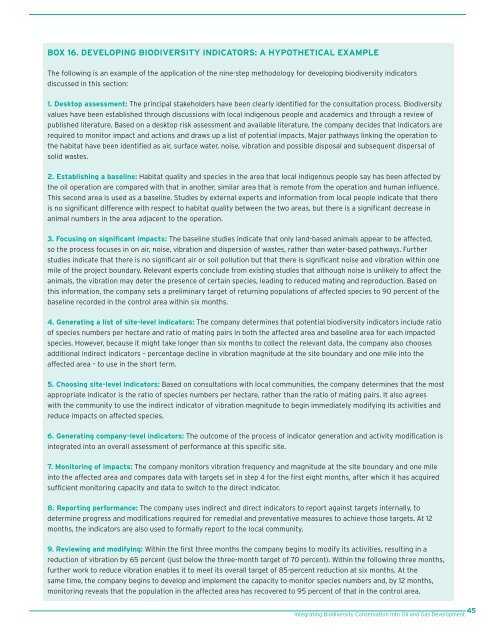Integrating Biodiversity Conservation into Oil and Gas ... - EBI
Integrating Biodiversity Conservation into Oil and Gas ... - EBI
Integrating Biodiversity Conservation into Oil and Gas ... - EBI
You also want an ePaper? Increase the reach of your titles
YUMPU automatically turns print PDFs into web optimized ePapers that Google loves.
BOX 16. DEVELOPING BIODIVERSITY INDICATORS: A HYPOTHETICAL EXAMPLE<br />
The following is an example of the application of the nine-step methodology for developing biodiversity indicators<br />
discussed in this section:<br />
1. Desktop assessment: The principal stakeholders have been clearly identified for the consultation process. <strong>Biodiversity</strong><br />
values have been established through discussions with local indigenous people <strong>and</strong> academics <strong>and</strong> through a review of<br />
published literature. Based on a desktop risk assessment <strong>and</strong> available literature, the company decides that indicators are<br />
required to monitor impact <strong>and</strong> actions <strong>and</strong> draws up a list of potential impacts. Major pathways linking the operation to<br />
the habitat have been identified as air, surface water, noise, vibration <strong>and</strong> possible disposal <strong>and</strong> subsequent dispersal of<br />
solid wastes.<br />
2. Establishing a baseline: Habitat quality <strong>and</strong> species in the area that local indigenous people say has been affected by<br />
the oil operation are compared with that in another, similar area that is remote from the operation <strong>and</strong> human influence.<br />
This second area is used as a baseline. Studies by external experts <strong>and</strong> information from local people indicate that there<br />
is no significant difference with respect to habitat quality between the two areas, but there is a significant decrease in<br />
animal numbers in the area adjacent to the operation.<br />
3. Focusing on significant impacts: The baseline studies indicate that only l<strong>and</strong>-based animals appear to be affected,<br />
so the process focuses in on air, noise, vibration <strong>and</strong> dispersion of wastes, rather than water-based pathways. Further<br />
studies indicate that there is no significant air or soil pollution but that there is significant noise <strong>and</strong> vibration within one<br />
mile of the project boundary. Relevant experts conclude from existing studies that although noise is unlikely to affect the<br />
animals, the vibration may deter the presence of certain species, leading to reduced mating <strong>and</strong> reproduction. Based on<br />
this information, the company sets a preliminary target of returning populations of affected species to 90 percent of the<br />
baseline recorded in the control area within six months.<br />
4. Generating a list of site-level indicators: The company determines that potential biodiversity indicators include ratio<br />
of species numbers per hectare <strong>and</strong> ratio of mating pairs in both the affected area <strong>and</strong> baseline area for each impacted<br />
species. However, because it might take longer than six months to collect the relevant data, the company also chooses<br />
additional indirect indicators – percentage decline in vibration magnitude at the site boundary <strong>and</strong> one mile <strong>into</strong> the<br />
affected area – to use in the short term.<br />
5. Choosing site-level indicators: Based on consultations with local communities, the company determines that the most<br />
appropriate indicator is the ratio of species numbers per hectare, rather than the ratio of mating pairs. It also agrees<br />
with the community to use the indirect indicator of vibration magnitude to begin immediately modifying its activities <strong>and</strong><br />
reduce impacts on affected species.<br />
6. Generating company-level indicators: The outcome of the process of indicator generation <strong>and</strong> activity modification is<br />
integrated <strong>into</strong> an overall assessment of performance at this specific site.<br />
7. Monitoring of impacts: The company monitors vibration frequency <strong>and</strong> magnitude at the site boundary <strong>and</strong> one mile<br />
<strong>into</strong> the affected area <strong>and</strong> compares data with targets set in step 4 for the first eight months, after which it has acquired<br />
sufficient monitoring capacity <strong>and</strong> data to switch to the direct indicator.<br />
8. Reporting performance: The company uses indirect <strong>and</strong> direct indicators to report against targets internally, to<br />
determine progress <strong>and</strong> modifications required for remedial <strong>and</strong> preventative measures to achieve those targets. At 12<br />
months, the indicators are also used to formally report to the local community.<br />
9. Reviewing <strong>and</strong> modifying: Within the first three months the company begins to modify its activities, resulting in a<br />
reduction of vibration by 65 percent (just below the three-month target of 70 percent). Within the following three months,<br />
further work to reduce vibration enables it to meet its overall target of 85-percent reduction at six months. At the<br />
same time, the company begins to develop <strong>and</strong> implement the capacity to monitor species numbers <strong>and</strong>, by 12 months,<br />
monitoring reveals that the population in the affected area has recovered to 95 percent of that in the control area.<br />
45<br />
<strong>Integrating</strong> <strong>Biodiversity</strong> <strong>Conservation</strong> <strong>into</strong> <strong>Oil</strong> <strong>and</strong> <strong>Gas</strong> Development
















![[PDF] Community Development Toolkit - CommDev](https://img.yumpu.com/48616495/1/184x260/pdf-community-development-toolkit-commdev.jpg?quality=85)
